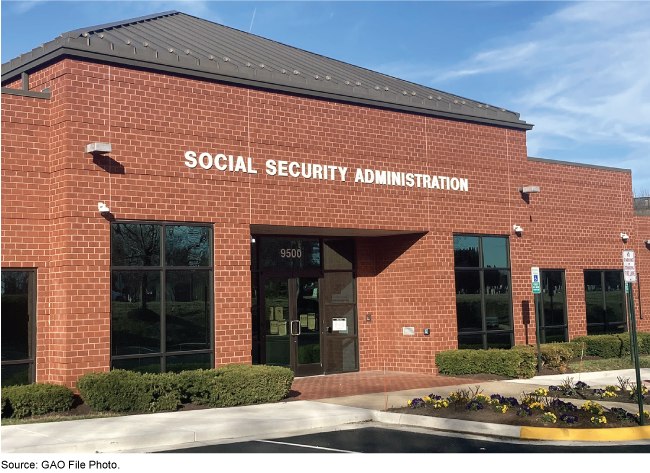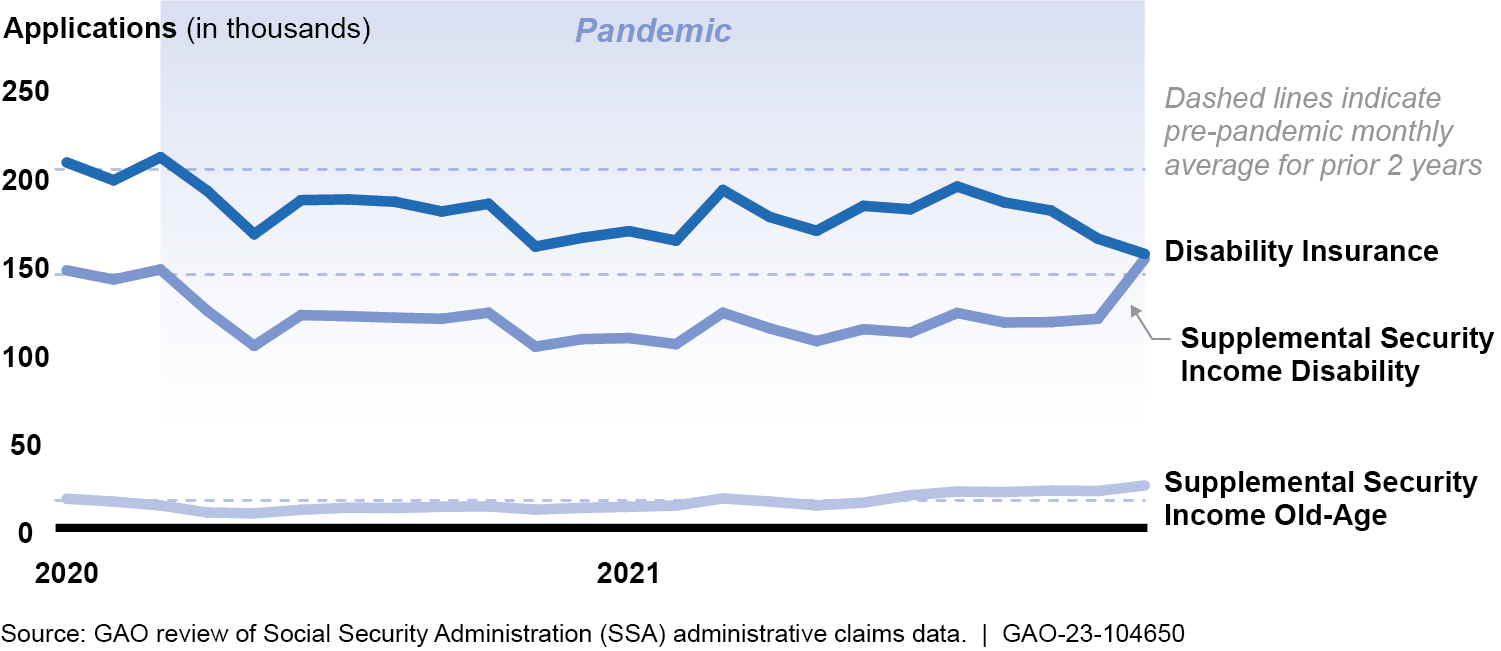Social Security Administration: Remote Service Delivery Increased during COVID-19, but More Could Be Done to Assist Vulnerable Populations
Fast Facts
The Social Security Administration changed how it delivered services due to COVID-19. It temporarily closed its offices to the public, with few exceptions, and expanded its telephone, video, and online services.
The public filed fewer SSA benefit claims during the pandemic—especially disability claims and claims by certain vulnerable populations. This may be in part because some benefit applications can't be submitted online, including those in Spanish.
Also, SSA doesn't have a coordinated process for addressing lessons learned from COVID-19 or a plan for handling higher future workloads. Our recommendations address these issues.

Highlights
What GAO Found
COVID-19 prompted the Social Security Administration (SSA) to make dramatic changes in the way it delivers services and administers its programs. On March 17, 2020, SSA closed its offices to the public—providing limited in-person visits for individuals with certain critical needs—and expanded remote service delivery options. SSA increased its use of telephone, mail, video, and online services. Through 2021, SSA established policies at field offices to increase the use of inoffice appointments. SSA also worked with state agencies that process claims for disability benefits to offer video options for certain medical exams. In April 2022, the agency reopened field offices to walk-in visits from the public.
The public filed fewer benefit claims with SSA during the pandemic, on average, compared to the prior 2 years, particularly for certain benefits and among certain vulnerable populations, according to GAO’s analysis of SSA data. For example, compared to the 2 years before the pandemic began, average monthly claims were lower from March 2020 through December 2021 for several SSA benefits. Specifically, they were 18 percent lower for Supplemental Security Income disability benefits, 12 percent lower for Disability Insurance, and 8 percent lower for Supplemental Security Income Old-Age, though Supplemental Security Income claims rebounded in late 2021. Some types of benefits claims declined more for certain populations, such as Spanish speakers.
Changes in SSA Benefit Claims (January 2020-December 2021)

SSA took steps to address a range of challenges with providing services remotely, but gaps remain in delivering services online and assessing lessons learned. SSA targeted outreach to certain vulnerable populations and expanded the use of third parties to help the underserved access benefits and services. However, not all claimants are able to apply for SSI online and applications in Spanish cannot be submitted online. As a result, SSA cannot fulfill its mission to ensure that its services are equitable and accessible, and some eligible individuals may not apply for benefits. Some SSA offices have assessed specific service delivery changes, but the agency does not have a coordinated process for assessing lessons learned from the COVID-19 pandemic and taking related corrective actions, which could leave SSA vulnerable to other crises in the future.
Why GAO Did This Study
In 2020, SSA provided benefits to nearly 70 million individuals. Under the CARES Act, SSA received $300 million to prevent, prepare for, and respond to COVID-19. The CARES Act includes a provision for GAO to monitor federal efforts to respond to the COVID-19 pandemic. GAO was also asked to review SSA’s response.
This report examines (1) changes SSA made to its delivery of key services; (2) the effect of these changes on the public, including certain vulnerable populations; and (3) how SSA addressed challenges it faced and identified lessons learned. GAO analyzed summary and administrative SSA data from March 2018 to December 2021, and reviewed the agency’s plans, policies, and guidance documents. GAO also conducted group interviews with SSA staff at various levels and offices; and interviewed SSA officials and external stakeholders, including disability advocates and employee groups.
Recommendations
GAO is making five recommendations, including that SSA develop detailed plans to enable claimants to apply for SSI online, evaluate the feasibility of making existing online applications available in Spanish, and implement a coordinated process for assessing lessons learned from the COVID-19 pandemic and incorporating them into future plans. SSA agreed with our recommendations.
Recommendations for Executive Action
| Agency Affected | Recommendation | Status |
|---|---|---|
| Social Security Administration | The Commissioner of SSA should develop a plan—with clear steps, goals, metrics, and timelines—to evaluate the feasibility of obtaining additional race and ethnicity data from other state and federal entities in support of its Equity Action Plan goals. (Recommendation 1) |
SSA agreed with this recommendation. In May 2023, SSA reported that it is implementing elements of its plan to obtain additional race and ethnicity data from other state and federal entities. They are seeking to record race and ethnicity data through the existing Enumeration at Birth (EAB) process, which coordinates the enumeration process with collection of information in State's bureaus of vital statistics. Over 99 percent of Social Security number requests for newborns in FY22 were completed using EAB. In FY24, SSA plans to coordinate with the National Association for Public Health Statistics and Information Systems to identify states that are willing and able to share race and ethnicity information and begin to facilitate collection of data from those states. As of April 2024, SSA continues these efforts and we will monitor their progress.
|
| Social Security Administration |
Priority Rec.
The Commissioner of SSA should develop a plan—with clear steps, goals, metrics, and timelines—for enabling claimants to apply for Supplemental Security Income (SSI) benefits online. (Recommendation 2) |
SSA agreed with this recommendation. In May 2023, SSA reported that its multi-year SSI Simplification Initiative, which includes the SSI Online project, aims to simplify and reduce delays in the SSI application process. Agency officials expect the Initiative to improve on-line service for claimants and employees, and produce a simple, secure on-line gateway to capture data; verify and determine eligibility; and notify claimants as their applications are being processed. As of April 2024, SSA continues to work on this recommendation. We will monitor the agency's progress on these efforts.
|
| Social Security Administration | The Commissioner of SSA should evaluate the feasibility of making online Spanish applications available again for those SSA benefit programs with existing online applications. (Recommendation 3) |
SSA agreed with this recommendation. In May 2023, SSA reported that it is considering reintroducing the Spanish iClaim application as part of a broader information technology modernization effort. To inform its decision, they plan to evaluate usage data, level of effort required to translate and host the application, and feedback from advocates. As of April 2024, SSA continues to work on this recommendation. We await further progress on these efforts.
|
| Social Security Administration | The Commissioner of SSA should implement a coordinated process for assessing lessons learned from the COVID-19 pandemic that includes documentation and dissemination, implementation of corrective action, and incorporation into future contingency planning. (Recommendation 4) |
SSA agreed with this recommendation. In May 2023, SSA said it would identify lessons learned for inclusion in its contingency planning documents. As of April 2024, SSA continues to work on this recommendation. We await further progress and documentation of these efforts.
|
| Social Security Administration | The Commissioner of SSA should develop an agency-wide plan for managing anticipated increases in SSA's disability workloads. (Recommendation 5) |
SSA agreed with this recommendation. In May 2023, SSA reported that in its FY 2024 President's budget, they requested resources to address increased initial disability claim receipts and the growing backlog based on actuarial receipt projections for initial disability applications in its field offices, Workload Support Units, State Disability Determination Services (DDS), and increased disability actions at subsequent levels of appeal. They factored into their budgetary resource estimate the expected increases in the disability workloads. They plan to increase agency and DDS processing capacity to address the growing disability workload. In addition, they are working on a comprehensive initial disability claims backlog reduction plan that will include activities in process, as well as plans for business process changes, information technology investments, and hiring. As of April 2024, SSA continues to work on this recommendation. We await the completion of these efforts.
|
